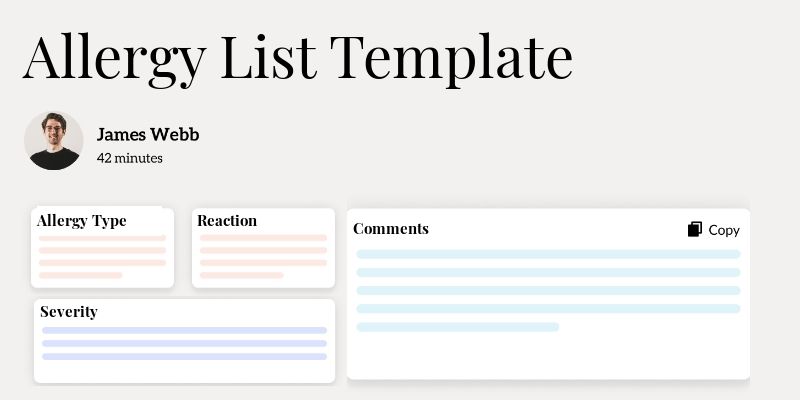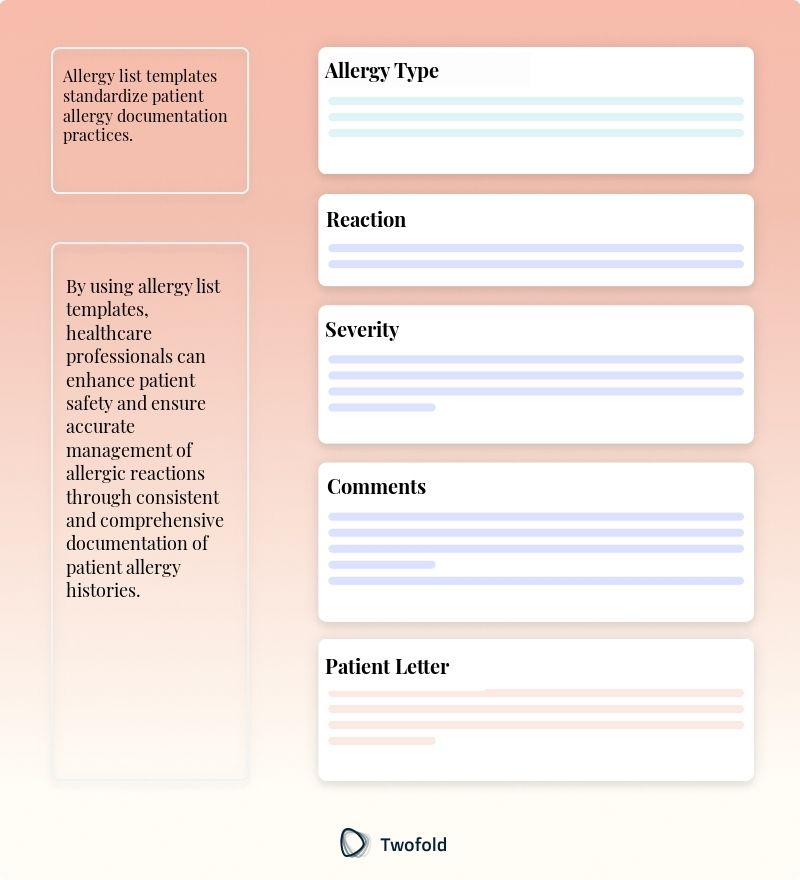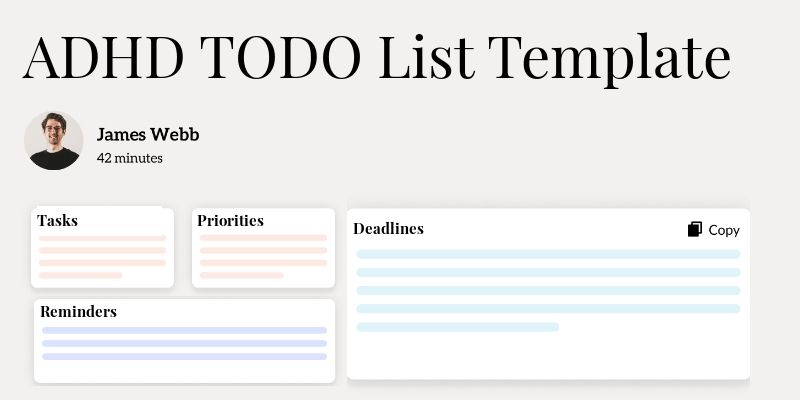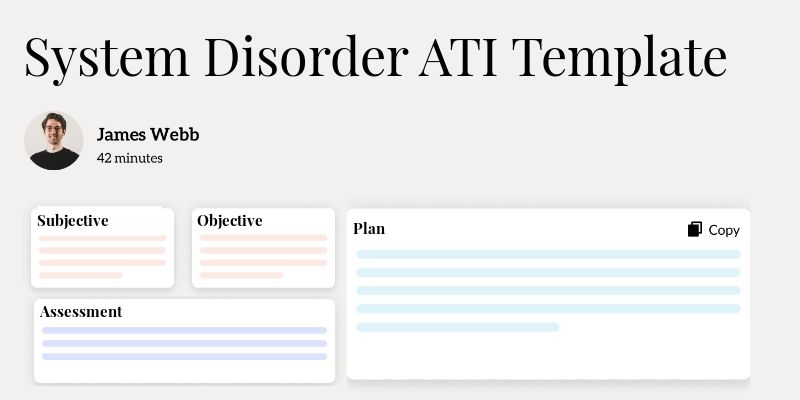
Allergy List Template
Managing allergies can often feel like juggling a myriad of concerns, especially when mistakes could have serious consequences. Have you ever found yourself overwhelmed by the complexity of keeping track of your patients' allergies efficiently? That's where the Allergy List Template comes in. This guide breaks down this pivotal tool, offering insights and strategies to transform your documentation process.
What Is an Allergy List Template?
An Allergy List Template serves as a systematic record of a patient's allergy history, documenting allergens and reactions. This organized framework aims to prevent adverse drug reactions and enhance the patient's safety during medical treatments.
This template ensures that healthcare providers have easy access to critical allergy information, which can be vital during emergencies and routine treatments alike. By standardizing this data, the Allergy List Template improves communication across medical teams and facilities.
Key Components of an Allergy List?
At its core, an effective Allergy List Template will consist of the following elements:
- Patient Identification: Information such as name, ID, and contact details.
- Documented Allergies: A list of allergens including medication, food, and environmental factors.
- Reaction Details: Descriptions of past reactions to each allergen.
- Severity Indicators: Visual or textual markers for the severity of reactions.
- Last Updated Date: The date when the information was last verified.
- Notes Section: Additional comments or observations by healthcare professionals.

How to Use an Allergy List Template: Step-by-Step Process
Step 1: Collect Patient Information
Begin by gathering the patient's basic details and any known allergies. This baseline data is crucial for building an accurate allergy list.
Step 2: Document Known Allergies
Input each known allergen into the template, specifying type and source—be it medication, food, or environment.
Step 3: Detail Reactions and Severity
Describe past reactions and assign severity levels. Highlight any allergens of immediate concern to alert healthcare providers quickly.
Step 4: Update Regularly
Review and update the template at each patient interaction to ensure its ongoing reliability and effectiveness.
Step 5: Share and Communicate
Ensure that the allergy list is accessible and communicated to all relevant medical staff involved in the patient’s care.
Benefits of an Allergy List
Benefit | Description |
|---|---|
Improved Patient Safety | Avoids harmful exposure to allergens, reducing the risk of adverse reactions. |
Streamlined Communication | Facilitates information sharing across medical teams, ensuring everyone is informed of potential risks. |
Enhanced Accuracy | Standardizes allergy documentation to minimize errors and discrepancies. |
Time Efficiency | Saves time for healthcare providers by providing quick access to critical allergy information. |
Stakeholders in Allergy List
The successful implementation of an Allergy List Template involves several key players:
- Healthcare Providers: Physicians and nurses who need quick and reliable access to allergy data. For example, a nurse reviewing a patient's chart before administering medication will use the list to prevent adverse reactions.
- Patients: Individuals contributing personal allergy information and ensuring their list is current. A patient may update their list with new allergies discovered during allergy testing.
- Pharmacists: Professionals ensuring medications prescribed do not trigger known allergies. They will cross-check prescriptions with the allergy list prior to dispensing.
- Emergency Personnel: First responders accessing allergy details in critical situations. For instance, paramedics will check for known allergies before treatment in emergency scenarios.
Example of an Allergy List PDF
A typical example of an Allergy List PDF includes fields for patient information, allergens, details of allergic reactions, and special instructions, all formatted for clarity and ease of use.
Real-World Use Cases: Practical Impact of the Allergy List Template
The versatile Allergy List Template has proven its value across numerous scenarios:
- A pediatrician updates a child's list after new allergy tests reveal sensitivities, ensuring future prescriptions are safe.
- An elderly patient uses the list during a hospital admission, preventing a potentially severe allergic reaction to a common medication.
- After a successful surgery, a patient avoids complications thanks to the surgical team's consultation of the allergy list.
- In a rural clinic, the template helps staff quickly acclimate to patient records, standardizing care despite a high turnover.
Conclusion
The Allergy List Template is an indispensable tool in the medical documentation toolkit. It enhances patient safety, ensures clear communication, and supports efficient, error‑free healthcare delivery. By integrating this template into daily practice, healthcare providers can maintain a high standard of care while mitigating allergy‑related risks.
Disclaimer: This article is for informational purposes only and does not constitute legal or medical advice. Always consult professional guidelines and regulatory bodies for specific compliance requirements.

Dr. Danni Steimberg
Dr. Danni Steimberg is a pediatrician at Schneider Children’s Medical Center with extensive experience in patient care, medical education, and healthcare innovation. He earned his MD from Semmelweis University and has worked at Kaplan Medical Center and Sheba Medical Center.
An allergy list is only life‑saving if it’s precise and current. The STAMP checklist ‑ Substance, Type of reaction, Anaphylaxis risk, Most recent episode date, Provider verification ‑ turns a static list into a dynamic safety net.
- Specify the Substance: Record both generic and brand names (e.g., “amoxicillin / Augmentin”) to prevent look-alike errors and ensure EHR alerts fire correctly.
- Tag Reaction & Risk: Pair each allergen with its exact reaction and note if it’s anaphylactic - this flags high-acuity cases for automatic order checks.
- Mark Date & Verification: Log the last reaction date and add a clinician’s initials each time the list is reviewed; this running timestamp proves diligence during audits and keeps the team in sync.
Frequently Asked Questions
Reduce burnout,
improve patient care.
Join thousands of clinicians already using AI to become more efficient.

ADHD TODO List Template
Discover practical ADHD TODO List Template to enhance your documentation efficiency.

System Disorder ATI Template
Discover practical System Disorder ATI templates to enhance your documentation efficiency.

Notice of Privacy Practices Template
Discover practical Notice of Privacy Practices Template templates to enhance your documentation efficiency.

